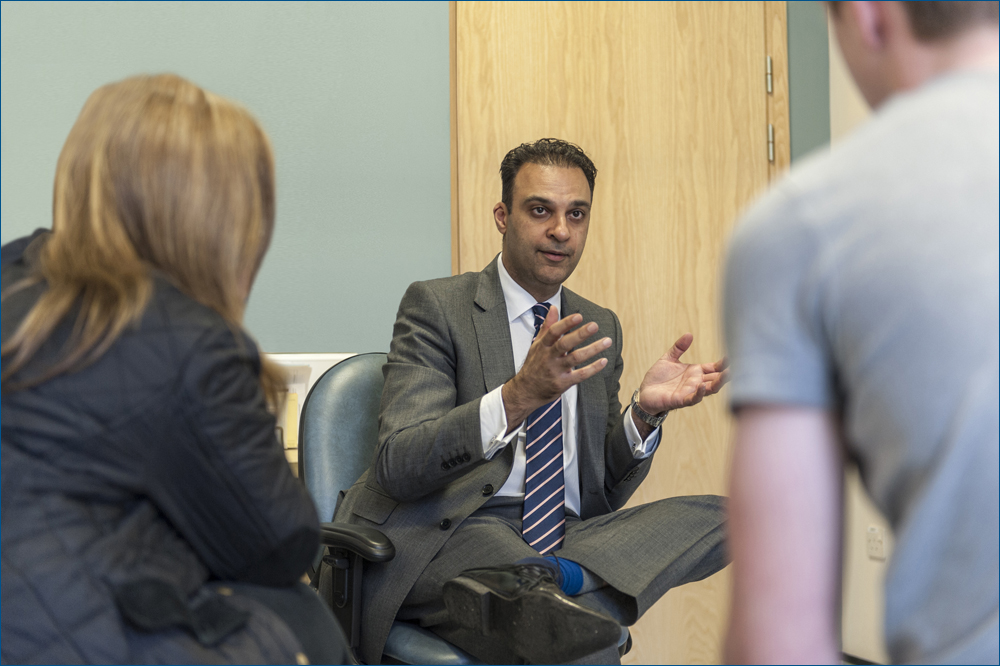OVERVIEW
One of the biggest developments in recent orthopaedics has been the introduction of robot-assisted surgery for joint replacement, which Mr Aslam has been performing at Spire South Bank Hospital since its arrival last year. Experts have described the technology as a “game-changer”, since it’s bringing new levels of precision and customisation to the knee replacement process.
WHAT IS ROBOTIC KNEE REPLACEMENT SURGERY?
In robot-assisted joint replacement, the surgeon uses a system called the Stryker Mako to help plan and perform these operations with an exceptional degree of accuracy. The Mako brings several major benefits to the pre-operative and surgical process.
It’s bespoke – the system uses advanced 3D modelling to map the anatomy of your knee and create a detailed individual plan for your operation, well before you come into theatre. It enables us to pre-plan the exact cuts we need to make before the procedure, and tailor them precisely to your joint. See How it works, below.
It’s precise – the Mako’s robotic arm can operate within a fraction of a millimetre. Its software provides a visual path for the surgeon as he makes the planned cuts and fixes the implant, while the arm uses tactile resistance to prevent him moving outside the planned boundaries. Preserving the maximum healthy bone and tissue is important in surgery, because it helps to reduce post-operative pain and speed recovery. See What the research is saying.
It’s time-tested – although the concept sounds futuristic, Mako has actually been operating since 2006 (see our surgical timeline, below). To date more than 100,000 Mako procedures have been carried out, over 700 surgeons around the world regularly perform it, and the technology has been covered by more than 50 peer-reviewed clinical publications.
It’s natural – ultimately a surgeon’s goal in knee replacement is to create a joint that feels as natural as possible for the patient. While no kind of surgery can provide a totally guaranteed outcome, the Mako’s accuracy, predictability and tailored approach is helping us to give our patients the best chance of a ‘best-fit’ replacement.
Robot-controlled? Not exactly…
The surgical component of the Mako is actually a highly calibrated arm, equipped with a specialised cutting tool: the official title is “robotic-arm assisted surgery”. Precision software guides the surgeon in making the pre-planned cuts with the arm, but the surgeon controls the arm and we can override the system at any time. In other words the Mako is more like a finely tuned assistant for the surgical team, helping to make a good operation even better.

How it works
(2) The scan takes x-ray images of your leg from multiple angles. We use the data from these images to generate a 3D virtual model of your knee. This is loaded into the Stryker Mako system to create a bespoke surgical plan for your joint, from the optimal implant size to the best angles for surgery.
(3) When the surgeon has reviewed the plan and adjusted it if necessary, it’s uploaded to the Spire South Bank hospital’s Mako robot. The robotic arm is equipped with a specialised surgical saw, which will remove the diseased portions of bone from your joint.
(4) On the day of the operation, a trained Stryker specialist joins the surgical team to run through the procedure plan, help the team prepare the Mako in theatre, and supervise it during the operation.
(6) The surgeon places reflective markers around the joint to synchronise your knee with the 3D model in the Mako system.
(7) The surgeon uses the robotic arm to remove defective bone from the knee, within the boundaries set out in the plan. The surgeon stays in control of the procedure, but the Mako uses real-time feedback to guide their movements and prevent them from straying outside the boundaries (the saw actually cuts out if the surgeon tries to do this). This builds precision into the process and helps preserve the optimal amount of healthy tissue.
(8) When the diseased bone has been removed, the Mako system ensures the implant is inserted into the joint space as planned. The surgeon carefully checks the range of movement in the knee, completes the operation and returns you to the recovery room.
(9) When you’ve woken up, Mr Aslam will visit you to talk through the procedure and check that you have everything you need. Over the next two days, we aim to get you mobilised as soon as possible – most patients are able to take their first steps within 24 hours, and to use stairs by day two or three.
(10) Depending on whether you’ve had a full or partial replacement, you should be ready to go home after two or three nights in hospital. We’ll see you again in two weeks to remove your stitches and dressing, and review your progress.









